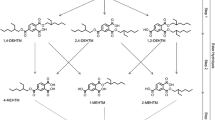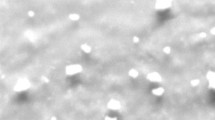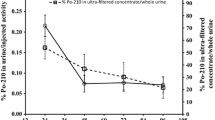Abstract.
The excretion of the dental composite component triethylene glycol dimethacrylate (TEGDMA) in feces and urine in vivo and, using the pendular perfusion technique with segments of jejunum and colon, the biliary and enteric excretion in situ were investigated in anesthetized guinea pigs. In the in situ experiments guinea pigs (n=4) received TEGDMA (0.02 mmol/kg body weight labelled with a tracer dose 14C-TEGDMA 0.7 kBq/g body weight) injected into the jugular vein. In the in vivo experiments guinea pigs (n=4) received TEGDMA (+14C-TEGDMA; same dose as above) via a gastric tube. Urine and feces were collected for 24 h. In the in situ experiments organs were removed from the guinea pigs 60 min after the beginning of the experiment, and the 14C radioactivity measured. During the 60-min perfusion period the calculated amount of 14C radioactivity excreted into the total jejunum and colon was 0.9±0.2% and 1.9±0.1% of the dose administered, respectively (means±SEM). Of the 14C-TEGDMA dose, 3.7±0.2% was found in the bile. A significantly (P<0.05) higher bile/blood concentration ratio was found 10 min after injection of TEGDMA as compared with the ratios at 20 to 60 min. The following 14C activities (percent of the dose) per total organ were found in guinea pigs (in situ experiment; means±SEM): 6.9±1.7 (muscle), 3.9±0.5 (kidney), 3.3±0.1 (skin), 1.4±0.1 (blood), and 1.2±0.1 (liver). The 14C activity in all other organs was <0.4%. The total 14C recovery in all organs tested was 17.5±1.8%. Over 24 h the amounts of 14C activity excreted in the feces and urine were 0.5±0.1% and 14.7±1.8% of the dose administered, respectively (means±SEM). The following 14C activities (percent of the dose) per total organ or contents of organs were found (means±SEM): 1.4±0.3 (liver), 0.8±0.3 (muscle), 0.5±0.1 (skin), and 0.5±0.1 (contents of cecum). The 14C activity in all other organs was <0.2%. The total 14C recovery in all organs tested was 3.9±0.9%. In a second series of in vivo experiments exhaled air from the animals was captured during the 24-h experimental period. Of the administered dose, 61.9±4.6% of the 14C (means±SEM; n=4) was exhaled as 14C-carbon dioxide. The results indicate a rapid clearance of 14C-TEGDMA and/or 14C-TEGDMA metabolite(s) from the organism and exhalation is the major route of elimination.
Similar content being viewed by others
Author information
Authors and Affiliations
Additional information
Electronic Publication
Rights and permissions
About this article
Cite this article
Reichl, F., Durner, J., Kunzelmann, K. et al. Biological clearance of TEGDMA in guinea pigs. Arch Toxicol 75, 22–27 (2001). https://doi.org/10.1007/s002040000159
Received:
Accepted:
Issue Date:
DOI: https://doi.org/10.1007/s002040000159




